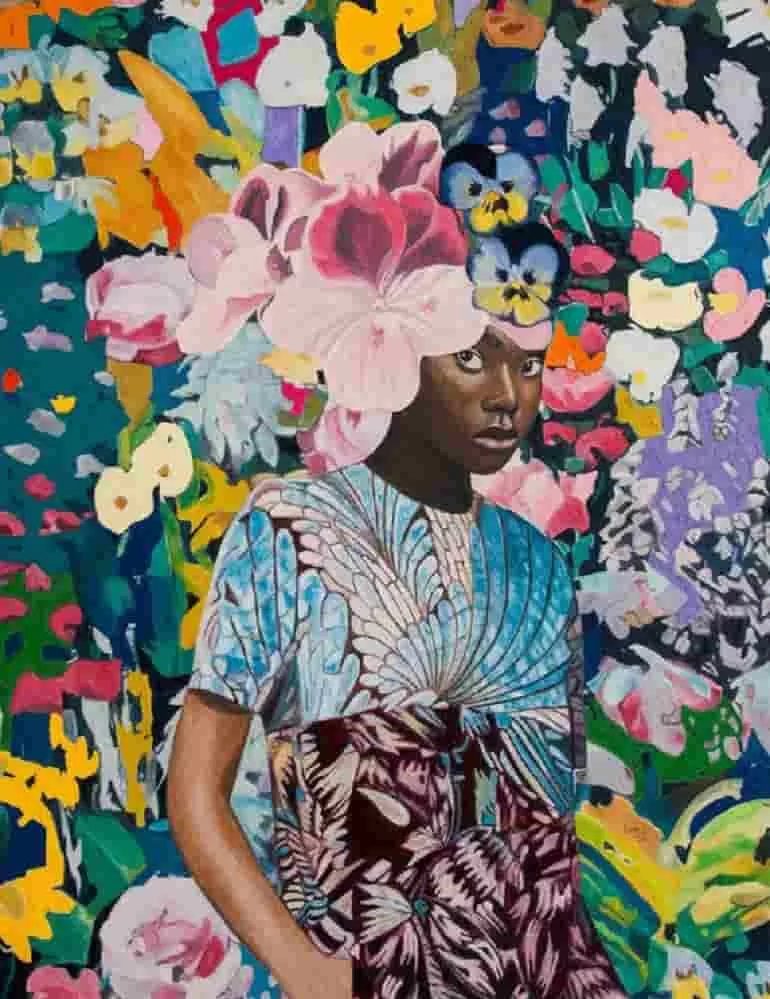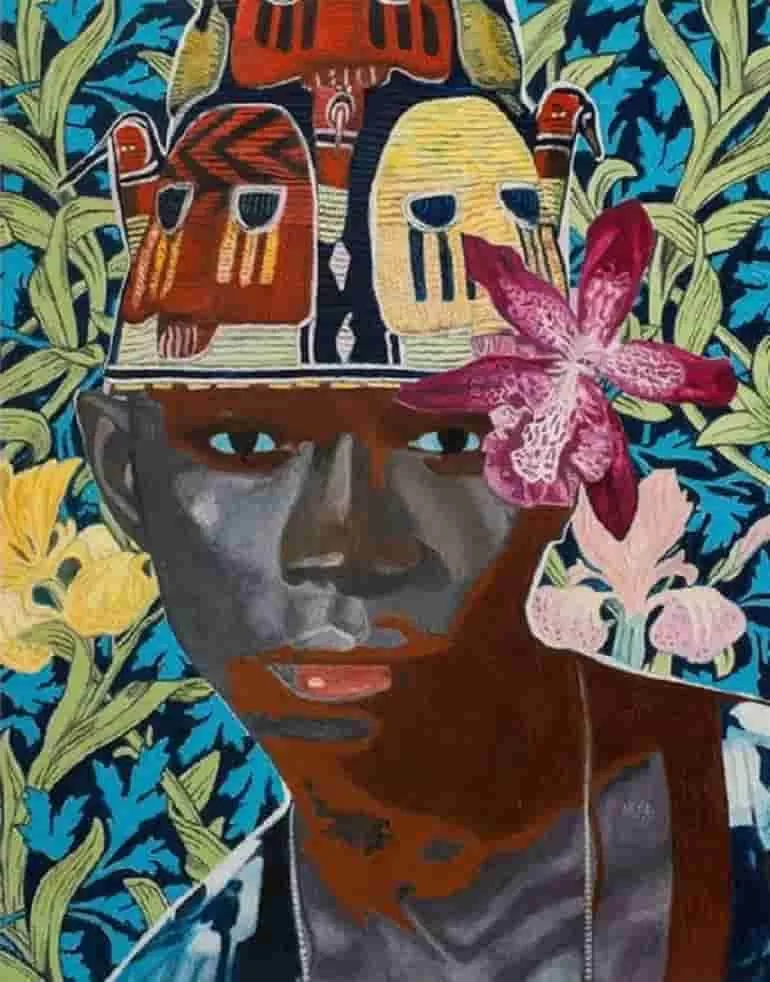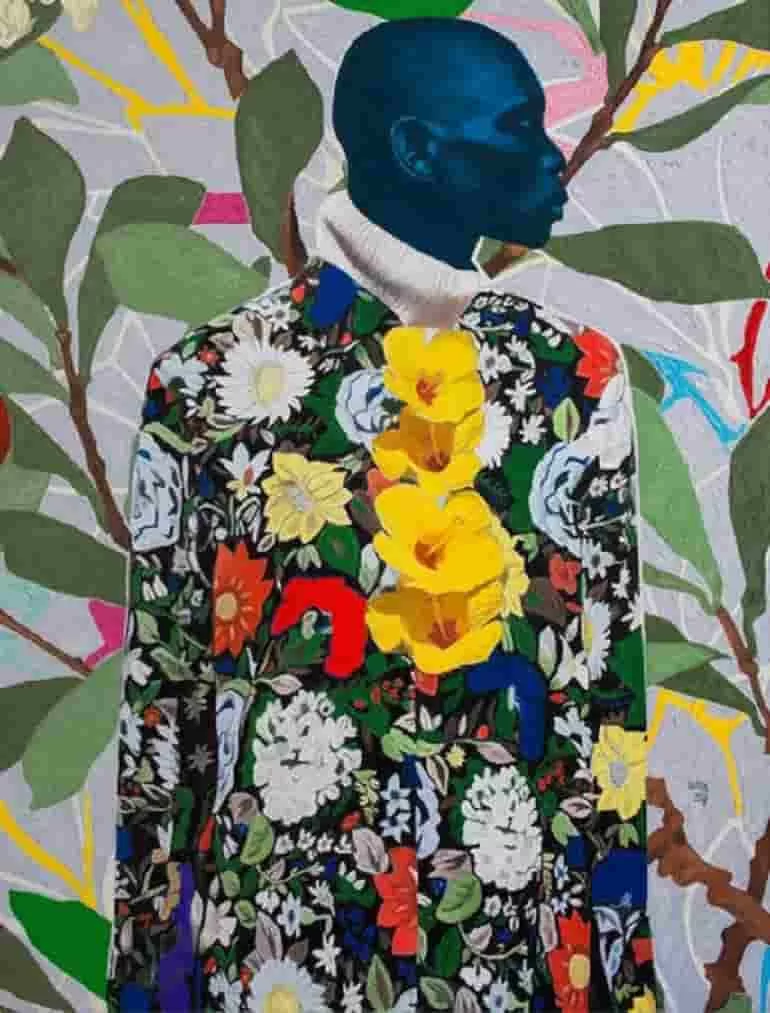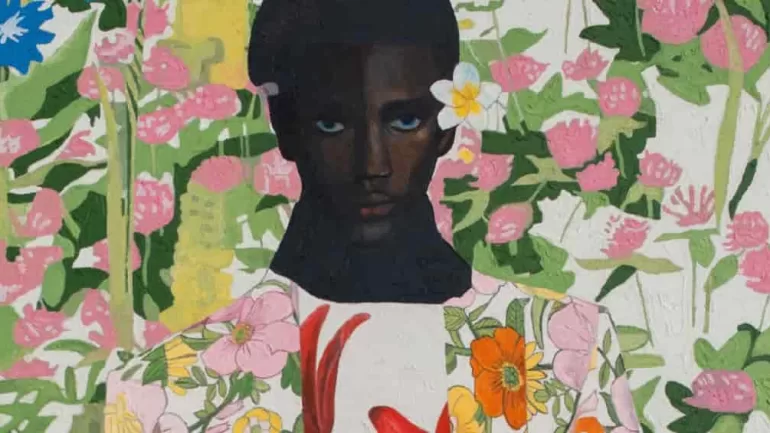ART & DESIGN
This detail from the painting titled The Deification of Legba by Wole Lagunju shows how the artist is using flowers to interrogate the perception of African Culture in Western metropolises. Image: Artist/Ebony/Curated.
In The Flowers on the Crown of the King, Wole Lagunju reimagines Yoruba heritage, using vibrant art to challenge global contemporary dialogues on power and identity.
BY KAZEEM ADELEKE, ARTCENTRON
In his highly anticipated eighth solo exhibition, Nigerian artist Wole Lagunju introduces The Flowers on the Crown of the King at Ebony/Curated in Cape Town. This exhibition marks a significant moment for Lagunju, as it is his second on the African continent. It reflects his ongoing exploration of Yoruba traditions. The new collection emphasizes both his cultural heritage and his ability to merge the past with the present.
Exploring Yoruba Traditions in Contemporary Contexts
Lagunju’s new works consist of eight large-scale paintings. Each piece explores his deep connection to Yoruba culture. At the same time, they engage in contemporary global art discussions. His art examines the intersections of identity, culture, and power, highlighting the dynamic changes within the African diaspora.
The Flowers on the Crown of the King offers a personal yet political reflection on African heritage. The exhibition delves into the complexities of balancing African roots with a global perspective. Like many African diaspora artists, Lagunju’s work questions the place of African culture within the broader international art world. His pieces provide a narrative that bridges the local with the global, offering both historical and modern viewpoints.
Lagunju’s distinctive approach to portraiture reimagines Yoruba cultural symbols. By integrating these symbols into wider conversations on gender, power, and identity, he blends tradition with modernity. His art challenges conventional narratives, reinterpreting historical symbols to demonstrate their ongoing relevance. Additionally, his work critiques colonial histories that continue to influence the present.
One of the notable works through which Wole Lagunju interrogates the hegemonic Western narrative about African culture is Contemporary Masquerades – The Gelede Mask I. In this painting, the artist revisits the Yoruba masquerading tradition. This tradition symbolizes renewal and rebirth. However, he moves away from the traditional sculptural masks and regalia of Gelede performances. Instead, he offers a fresh perspective, which reflects both continuity and change in the expression of modern identity and culture.
Flowers, Yoruba Culture, and Western Hegemony
All the works in this exhibition reaffirm Lagunju’s love of flowers. His use of flowers in his paintings goes beyond the simple aesthetics of natural beauty. Lagunju’s exploration of floral imagery has become an essential tool for confronting and challenging the dominant Western historical perspectives. He also uses it to celebrate the rich cultural heritage of the Yoruba people. Through his artistic journey, Wole Lagunju not only critiques colonial history but also redefines identity, gender, and power within the African context.
Flowers as Symbols of Cultural Resistance
Lagunju’s art is deeply embedded in the Yoruba cultural philosophy, which is intertwined with his critique of Western cultural hegemony. In his work, flowers are not just ornamental; they serve as vehicles for cultural assertion. The artist creates an intersection of two worlds by transposing flowers found in Western popular media with Yoruba cultural iconography—one that seeks to challenge the stereotypical dominance of the West and another that reclaims and redefines African identity.
By placing Yoruba cultural symbols, often sidelined in Western institutions, within these floral contexts, Lagunju is forcefully inserting African heritage into spaces that have traditionally excluded it. His juxtaposition of cultural objects from Yoruba tradition with flowers commonly found in Western imagery allows for a re-imagining of narratives in a post-colonial world. This critical artistic appropriation offers new stories of multiculturalism and a more nuanced understanding of contemporary African art history.
To Pluck a Flower (Ododo): A Symbol of Love and Feminine Power

One of the most profound examples of Lagunju’s artistic exploration of flowers is his painting titled To Pluck a Flower (Ododo). This work is imbued with deep cultural significance and showcases Lagunju’s ability to merge the Yoruba language with visual art. The painting features a young woman wearing an adire garment, a traditional Yoruba fabric that is both culturally rich and historically significant. The woman’s expression, gazing directly at the viewer, communicates a powerful sense of identity and self-awareness.
Surrounding her, and in the background, are various species of flowers. These flowers are not only symbolic of natural beauty but also of the Yoruba concept of love. The phrase “Mo ja ododo,” which translates to To pluck a flower, carries deep cultural resonance. In the Yoruba tradition, this phrase can symbolize love, beauty, and femininity. The work speaks to the joy of falling in love, especially in the context of courtship and romantic relationships. The visual language of flowers, in this case, connects directly to the emotional expression of love, desire, and the complexities of gender and feminine identity in Yoruba culture.
Through To Pluck a Flower, Lagunju invites the viewer into a space of emotional connection. He forces a reflection on love, identity, and beauty in a post-colonial context. The juxtaposition of the woman’s serene gaze with the flowers surrounding her underscores the idea that these cultural symbols—flowers and femininity—have been historically misunderstood or misrepresented. Lagunju reclaims them, weaving a narrative of empowerment, cultural pride, and self-expression.
Navigating Contemporary Fashion and Royal Iconography

Lagunju’s exploration of flowers takes a new turn in his recent works, particularly when examining the floral iconography found on Yoruba royal crowns, or ‘Ade.’ These crowns are traditionally worn by Yoruba kings. They are adorned with intricate designs, including flowers and other motifs that symbolize royalty and spiritual power. The flowers in these crowns are not mere decorations; they represent a deeper connection to the divine and the rich history of the Yoruba people.
In his painting The Flowers on the Crown of the King, Lagunju merges these royal symbols with his signature flower imagery. The subject of the painting—a man wearing a Yoruba crown—gazes into the viewer’s eyes, exuding a sense of power and authority. However, the crown is not depicted in its traditional role as a symbol of kingship. Instead, Lagunju transforms it into a fashion accessory, signaling a departure from the conventional representation of royal power. The placement of flowers on the crown and the contrast between the crown and the flowering background speak to the ongoing evolution of cultural identity, where tradition and contemporary life intersect.
By using flowers in this context, Lagunju critiques the commodification of African symbols in the globalized art market. The flowers that decorate the crown are a visual language that connects both the traditional and the modern. They highlight the dynamic relationship between Yoruba culture and global fashion trends.
Wole Lagunju: Fashion, Masculinity, and the Role of Flowers

In Thoughts of Longing (2024), Lagunju explores the intersection of fashion, masculinity, femininity, and the visual power of flowers. This piece features a dominant male figure dressed in a brightly colored, flowery shirt over a turtleneck sweater. The shirt is adorned with yellow daffodils arranged in such a way that they force the viewer’s attention to the figure’s face, where his powerful expression exudes masculinity and strength.
The flowers on the shirt are not there simply for decorative purposes. They serve as a visual contrast to the model’s sharp, defined features, including high cheekbones and a square jaw, which evoke a sense of strength and pride. The figure’s gaze is intense, further emphasizing his masculine presence and the self-assuredness that radiates from his image. The background of gray and green plants serves as a backdrop to this powerful visual representation. This compositional approach makes the figure stand out even more vividly.
Lagunju’s use of flowers in this piece challenges the conventional boundaries of gender expression. While flowers connote femininity and softness, here, they intertwine with the masculine form. This ability to engender duality highlights the artist’s power to deconstruct societal norms around gender and beauty. The use of flowers to accentuate the figure’s powerful, masculine features invites the viewer to reconsider preconceived notions about what flowers represent and how they can be used to convey complex cultural and gendered identities.
The Interplay of Global and Local Flower Culture in Lagunju’s Work
Lagunju’s art is a powerful reflection of his engagement with both global flower culture and his Yoruba heritage. His work demonstrates the fluidity with which flowers can transcend geographical and cultural boundaries, creating a visual language that resonates on a global scale. Through his use of flowers, Lagunju establishes a unique voice that speaks not only to Yoruba traditions but also to a broader international audience. The intercultural connections he draws through his paintings bridge the gap between local and global visual cultures. He presents a dynamic exchange of ideas and symbols.
His adaptation of flowers within the context of Yoruba art brings a new layer of meaning to the concept of ‘Oju Ona’—the Yoruba term for eye for design. This phrase underscores the importance of aesthetic sensibility in Yoruba culture. Lagunju’s work exemplifies his understanding of this principle by blending traditional design principles with modern visual elements. In doing so, he creates art that has roots in cultural history and is remarkably relevant to contemporary global art discussions.
The Hybridization of Art and Culture: A Visionary Approach
At the heart of Lagunju’s artwork lies a hybridized visual language that speaks to both individual and collective experiences. His use of Onaism—an artistic movement within Yoruba tradition—serves as a critical lens through which he reinterprets the Gelede tradition. By merging vibrant Yoruba masks with Western cultural symbols, Lagunju creates a unique visual dialogue. This conversation confronts and critiques established cultural narratives related to race, gender, and power.
His work offers a thought-provoking critique of colonialism while also celebrating the richness of African culture. The fusion of Yoruba heritage with contemporary iconography highlights the evolving nature of African art in the diaspora. It illustrates how artists like Lagunju are navigating and challenging the complexities of their cultural identities while celebrating the strength and endurance of African traditions.
Lagunju’s Recognition and International Impact
Wole Lagunju has received numerous accolades throughout his career. They include the Northern Trust Prize in 2023 and the Pollock Krasner Award in 2009. In 2006, he received the Philip L. Ravenhill Fellowship from UCLA. His works are in prominent public collections such as the Denver Art Museum and St. Louis Art Museum. They are also in the Indianapolis Museum of Art at Newfields and the Toledo Museum of Art, among others.
Lagunju’s art continues to resonate globally, not only within the African diaspora but also in broader international contexts. His paintings challenge the way people perceive African art. They are an important commentary on contemporary global issues, including the legacies of colonialism. Above all, they are reminders of the ongoing struggles for cultural preservation and power.
Wole Lagunju: Celebrating the Enduring Spirit of African Art
The Flowers on the Crown of the King is a testament to Wole Lagunju’s ongoing commitment to exploring and reimagining Yoruba traditions within contemporary art. By combining elements of the past with new interpretations, his work offers a dynamic and powerful reflection on the intersection of culture, power, and identity. His unique perspective and hybrid approach continue to inspire conversations about the place of African culture in the global contemporary art scene. Through his art, Lagunju celebrates the richness of his heritage. But more importantly, he challenges viewers to consider the role of culture in shaping both personal and collective identities in today’s world.
Lagunju’s use of flowers in his artwork is more than a visual motif. For him, it is a tool for cultural resistance, reclamation, and self-expression. His paintings engage with the tension between Western colonial history and African identity, using flowers as symbols of beauty, strength, and cultural pride. Through his work, Lagunju navigates complex issues of gender, power, and identity. He offers new ways to think about African heritage in a globalized world.
The intersection of Yoruba culture and Western influence in his work creates a space for reflection. It promotes dialogue, reimagining the narratives that have historically been marginalized. As his art evolves, Lagunju’s floral imagery will remain a powerful tool for expressing the complexities of multiculturalism and contemporary African art.
